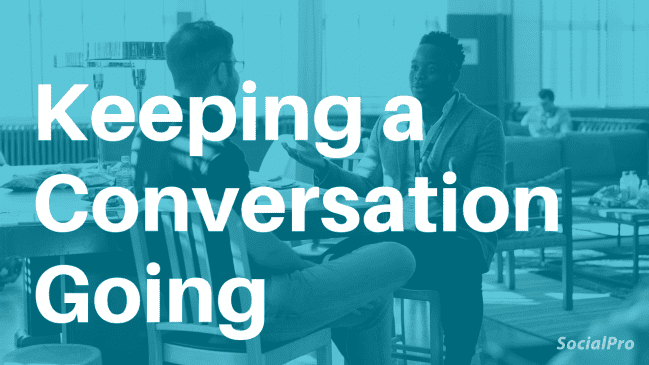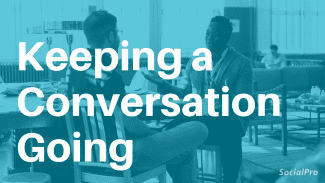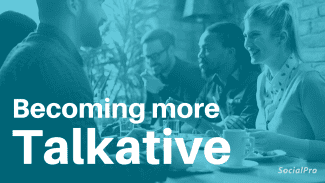I often had trouble making conversations and ran into awkward silences a lot.
When I made friends with socially savvy people, I learned how to keep my conversations going. In this guide, I’ll show you how to carry on a conversation.
This will make you more confident in social situations and help you make friends.
Watch this video for a summary of the article:
Sections
22 tips to keep a conversation going
Knowing what to say and how to keep the interest of the other person isn’t easy. These tips will help you to keep a conversation going:
1. Ask open-ended questions
Close-ended questions invite only two possible answers: yes or no.
Examples of closed-ended questions:
- How are you today?
- Was work good?
- Was the weather nice?
Open-ended questions, on the other hand, encourage longer answers.
Examples of open-ended questions:
- What have you been up to today?
- What did you do at work today?
- What’s your ideal kind of weather?
Close-ended questions aren’t always bad! But if you have a hard time getting a conversation going, you can try to ask an open-ended question every once in a while.
“But David, if I ask someone what they did at work, they might just say, “Oh, the usual.”
Right! When we ask questions like this, people often think we’re just being polite. (It could also be that they’re busy or don’t want to talk. Read my guide here on how to know if someone wants to talk to you.)
To show that we actually want to continue the conversation, we need to…
2. Ask follow-up questions
To show that you actually care about how someone answers your questions, follow up with further questions. When our conversations die out, it’s usually because we don’t come off as sincere and interested enough.
Example:
- You: “What have you been up to today?”
- Them: “Working, mainly.”
- You [Follow up]: “How’s work going for you at the moment?”
- Them: “Well. I think it’s going…” (Your friend is more motivated to give a longer answer as you’ve asked a follow-up question, and this keeps the conversation going)
“But David, I don’t want to come off as an interrogator and ask questions all the time.”
In between the questions, you want to share a little bit about yourself as well. I have a trick to get this balance right. It’s called the IFR method:
3. Balance between sharing and asking questions
To find a good balance between sharing and asking questions, you can try the IFR-method.
IFR stands for:
- Inquire – Ask a sincere question
- Follow-up – Ask a follow-up question
- Relate – Share something about you to break up your questions and keep the conversation balanced
Example:
- You [inquire]: What’s your ideal kind of weather?
- Your friend: Hmm, I think around 65 so I don’t sweat.
- You [follow-up]: So living here in LA must be way too warm for you?
- Your friend: Yeah, I use the AC a lot!
- You [relate]: I like it when it’s hot but only on holidays. On workdays, I like it cool so I can think better.
Now, you can repeat the sequence by inquiring again:
- You [inquire]: Does the heat make you drowsy?
After they’ve replied, you can follow up, relate, inquire, and so on.
See how the IFR method creates this nice balance in the conversation?
“But David, how do I come up with these questions in the first place?”
For this, I imagine a timeline…
4. Imagine the other person as a timeline

To get a conversation going, visualize a timeline. Your goal is to fill in the blanks. The middle is “now,” which is a natural point to start the conversation. So you start talking about the very moment you’re in, then work your way back and forth along the timeline.
A natural conversation ripples away from the current moment into both the past and the future. It can start off with a few banal comments about how the food you’re eating at dinner is nice and can end up being about dreams or childhood.
Examples:
Questions about the present moment
- “How do you like the salmon rolls?”
- “Do you know the name of this song?”
Questions about the near future
- “What kind of work do you do/what are you studying? How do you like it?”
- “What are you going to do during your visit here in [place]?”
- “How was your trip here?”
Questions about the medium and long-term future
- “What are your plans when it comes to…?”
- “Is work busy, or do you get any time off? Do you have any plans for your next vacation?”
- “Where are you originally from? How come you moved?”
- “What do you do when you’re not working?”
By imagining a visual timeline of someone’s present, past, and future, you’ll be able to come up with questions more easily.
Related: How to be more interesting to talk to.
5. Avoid asking too many questions in a row
I compiled the questions above as a list for your reference. However, you don’t want to interview the other person — you want to have a conversation. In between these questions, share relevant things about yourself. The conversation might take off in any direction, far away from the timeline.
(Here’s my guide about how to have a conversation without asking too many questions.)
6. Be genuinely interested
Don’t ask for the sake of asking questions – ask them so you can get to know someone!
Here’s how to get a conversation going: show a genuine interest in people. When you do, they’ll be much more motivated to share and to ask sincere questions about you, too. Here’s a list of 222 questions to get to know someone.
7. Find mutual interests to talk about
To get a conversation going past the small talk, you sooner or later need to find a mutual interest to talk about. That’s why I ask questions or mention things I think people might be interested in.
What do you think the person you talk about might like to talk about? Literature, health, technology, arts? Luckily, we can often make assumptions about what someone might be interested in and bring it into the conversation.
If you read a lot, you could say, “I just finished this book called Shantaram. Do you read a lot?”
If you don’t get a positive response, try asking about something else or mentioning something else at a later time. So if you mention books, but the other person doesn’t seem interested, you could say, “I finally got around to seeing Blade Runner. Are you into sci-fi?”
Why are mutual interests so powerful to get a conversation going? Because when you find one, you’ll get that special connection that you only get with people you share interests with. At this point, you can leave small talk behind and discuss something you both really enjoy.
8. Face the other person and keep eye contact
If you feel uncomfortable or don’t like being around people, you might intuitively look or turn away from the person you’re talking to. The problem is that people interpret this as disinterest or even dishonesty,[1] which means they won’t want to invest in the conversation.
Make sure to do the following, To really signal that you’re listening, be sure to:
- Face the person
- Keep eye contact as long as the person is talking
- Give feedback like nods and “hmm’s”
To learn more about making and keeping eye contact, see this guide to confident eye contact.
9. Use the FORD rule
Talk about Family, Occupation, Recreation, and Dreams. These are safe topics that work in most situations.
To me, family, occupation, and recreation are topics for small talk. The really interesting conversations are about passions, interests, and dreams. But you need to make small talk before people are comfortable enough to dive deeper into more fascinating topics.
10. Avoid coming on too strong
Whenever someone’s too eager to talk, they come off as a bit needy. As a result, people are more reluctant to talk to them. I’ve been guilty of this mistake myself. But you don’t want to go too far in the opposite direction and appear standoffish.
Try to be proactive (as we’ve discussed in this guide), but don’t rush it. If you’re talking to a colleague at work or someone you’ll meet repeatedly, there’s no need to hit them with lots of questions. You can get to know someone and share things about yourself over the coming days and weeks.
Be warm and approachable, but accept that socializing and making friends takes time. Research shows that people become friends after spending around 50 hours together.[2]
11. Practice being OK with silence
Silence is a natural part of conversations. The silence is only awkward if you panic and make it awkward.
A friend who’s very socially savvy taught me this:
When there’s an awkward silence, that doesn’t mean that it’s only you who needs to come up with something to say. The other person probably feels the same pressure. Practice being comfortable with silence at times. If you continue the conversation in a relaxed manner, rather than stress out while trying to think of something to say, you’ll help the other person relax too.
12. Return to a previous topic
Conversations don’t have to be linear. If you hit a dead-end, you can take a few steps backward and talk about something the other person mentioned in passing.
For example:
- “So, tell me more about that trip to Amsterdam you mentioned earlier. I’d love to hear about what you did there.”
- “I think you said that you’ve just started learning how to paint in oils? How’s that going?”
13. Tell a story
Brief, interesting stories can make a conversation livelier and help other people get to know you better. Have two or three stories ready to tell. They should be easy to follow and portray you as a relatable human being.
See this guide on how to be good at telling stories for more tips.
If someone enjoys your story and they have a good sense of humor, you could ask them for a story in return. For example, you could say, “OK, that’s my most embarrassing moment this year. Your turn!”
14. Stay well-informed
Taking 10 minutes every day to skim the news and the latest social media trends can help you out if a conversation dries up. Read a few obscure or amusing stories too. If you are generally well-informed, you’ll be able to have a serious or light-hearted conversation, depending on the context.
15. Say whatever is on your mind
This technique is sometimes called “blurting” and is the opposite of overthinking. When you are trying to think of something to say, go for the first thing that comes to mind (unless it is offensive).
Try not to worry about coming off as clever or witty. If you pay attention to people making conversation, you’ll notice that most of the things they say are quite mundane – and that’s OK.
You don’t always want to blurt things out. However, doing it as an exercise for a period of time can help you overthink less.
16. Ask for advice or a recommendation
Asking someone for advice about a topic they love is a good way to start a conversation about their interests. The conversation will also be enjoyable for you because you’ll get some useful information.
For example:
- “By the way, I know you’re really into tech. I need to upgrade my phone soon. Are there any models you’d recommend?”
- “It sounds like you’re a really keen gardener, right? Do you have any tips for getting rid of aphids?”
17. Prepare topics in advance
If you are going to a social event and know who will be there, you can prepare a few conversation topics and questions in advance.
For example, if you are going to a friend’s party and know that they have invited a lot of their old medical school friends, there’s a good chance that you’ll meet some doctors. You could prepare a few questions about what it’s like to work as a doctor, how they chose their career, and what they most enjoy about their job.
18. Have a beginner’s mind
When someone starts talking about a topic that is totally alien to you, take advantage of the fact you have no background knowledge. Ask them some beginners’ questions. They can start a great conversation, and the other person will feel as though you really care about their interests. Good beginners’ questions include:
- “What exactly does [their hobby or field] involve?”
- “How do you/how did you learn [their skill]?”
- “What do people struggle with most when they start out?”
- “What’s your favorite thing about [their hobby or field]?”
19. Stay positive
If you criticize someone else’s interests, they probably won’t want to talk to you, and the conversation might become awkward.
Instead of criticizing, try the following:
- Challenge yourself to find out why the person likes their hobby so much. There might be more to their interest than you think.
- Try to find some common ground. For example, if someone talks about their love of horse riding and you find it boring, you could broaden the topic and start talking about outdoor sports as a general topic. From there, you could talk about nature, keeping fit, or environmental issues.
20. Mirror their question
If someone asks you a question, it’s likely that they would be happy to talk about the same topic.
For example:
Them: What do you like to do on weekends?
You: I usually hang out with friends every Friday and play board games. Sometimes a few of us will take a hike or go see a movie on Saturdays. The rest of the time, I like to read, spend time with my family, or try out new recipes. What about you?
21. Look around you for inspiration
Pair an observation with a question. For example, if you are talking to someone at a wedding, you could say, “This is such a beautiful venue for a wedding ceremony! How do you know the couple?”
Even a plain space can kick start a conversation. For example, let’s say you’re in a boring, white conference room waiting for a meeting to start.
You could say, “I sometimes think conference rooms should be a bit friendlier. If I had the chance, I’d put a sofa there [points], maybe a nice coffee machine…it could be a cool space actually!” This could start a discussion about interior design, coffee, furniture, or workspaces in general.
22. Make and test assumptions
For example, if you are talking to a motorcycle enthusiast, it makes sense to ask them questions about bikes or biking.
But you can go a step further. Ask yourself, “What does this interest of theirs suggest about them? What else might they like or enjoy?”
In this case, you might guess that someone who loves biking might also like:
- Road trips/travel
- High-energy/extreme sports
- Aspects of biker culture aside from riding, such as tattoos
You don’t have to ask them direct questions about these topics. You can weave them into the conversation in a natural, low-key way.
For instance, instead of saying, “So, do you have any tattoos?” or “You like bikes, does that mean you like tattoos?” you could talk about tattoos you’d like to get (if it’s true) or a cool tattoo you saw on someone else. If your assumption is correct, they will happily go along with the topic.
How to keep a conversation going online
Most of these tips in this guide also apply when you’re talking to someone online. Whether you meet in person or on the internet, you want to have a balanced conversation, discover what you have in common, and get to know each other.
Here are a few extra tips for online conversations:
1. Use photos, songs, and links as talking points
Send a photo of something unusual or funny you noticed, a song you like, or a link to an article that made you think of the other person. Tell them what you think of it and ask for their opinion.
2. Share an activity online
Shared activities can spark conversation in person, and the same goes online. For example, you could watch a movie together, take the same personality quiz, take a virtual tour of a museum, or listen to the same playlist.
3. Suggest a voice or video call
Some people find it hard to express themselves via messages but are good at real-time conversations. If you’ve met someone online that you like, but the conversation is slightly awkward, ask them if they’d be happy to chat on the phone or via video.






Good
What an awesome article. I am a Dr. of Occupational Therapy and a Professional Life Coach. I also have a company , “The Guerrette Institute”. My company is five years young. I found your wonderful article. I can not say it any better. I would like to use your article as a teaching tool for The Coaching Conversation and Opened Ended Closed ended questions. Thank you so much for all your knowledge.
Looking forward to encorporated colaboration,
Dr. Sue